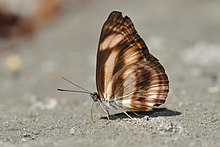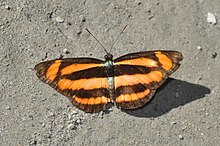| Yellowjack sailer | |
|---|---|

| |
| Ventral View | |

| |
| Dorsal View | |
| Scientific classification | |
| Domain: | Eukaryota |
| Kingdom: | Animalia |
| Phylum: | Arthropoda |
| Class: | Insecta |
| Order: | Lepidoptera |
| Family: | Nymphalidae |
| Genus: | Lasippa |
| Species: | L. viraja |
| Binomial name | |
| Lasippa viraja (Moore, 1872) | |
| Synonyms | |
|
Neptis viraja | |
Lasippa viraja, the yellowjack sailer, is a species of nymphalid butterfly found in South Asia.
Subspecies
The subspecies of Lasippa viraja are:
- Lasippa viraja viraja Moore, 1872 – northeast India, Nepal, Myanmar
- Lasippa viraja kanara Evans, 1924 – south India
- Lasippa viraja nar de Nicéville, 1891 – Andamans
Description
Males and females upperside black; markings orange yellow. Forewing: discoidal streak very broad and long, descending a little below vein 4; a short broad band sloping obliquely outwards from middle of dorsum to beyond vein 3, another short broad and somewhat clavate (club-shaped) band sloping obliquely outwards from apical third of costa to below vein 5; beyond these, a subterminal slender line. Hindwing: a subbasal, transverse, very broad, somewhat paler yellow band; a postdiscal slightly narrower transverse band, not quite reaching the costa, anteriorly attenuate, curved slightly inwards; a very faint and ill-defined pale subterminal line. Underside dusky brownish black, the markings as on the upperside but much blurred. Forewing with two subterminal slender lines, the outer not clearly defined. Hindwing: the costa at base yellowish; discal and subterminal pale narrow bands. Antennae, head, thorax and abdomen black; beneath, the palpi, thorax and abdomen greyish white, the abdomen slightly ochraceous. There is very little difference between the sexes, or between the wet- and dry-seasonal broods; the latter are on the whole paler both in ground colour and markings.
Wingspan 56–68 mm.
Distribution
Sikkim; Bhutan; Bengal; Orissa; southern India; Assam; Burma and Tenasserim; Thailand; Laos.
Larva
"Feeds on the blackwood tree (Dalbergia latifolia) and also on Dalbergia racemosa and has similar habits to those of N. hordonia, Stoll, which it resembles in form, but the head is bifid at the top, and the dorsal points are wanting, while the last-segment is produced into a single blunt point. The colour is dark greenish brown, the fore part, as in N. hordonia, being much darker than the rest, but bordered with pale grey." (Davidson, Bell & Aitken)
This form, as recorded by Mr. Bell, feeds, like N. hordonia, on decayed (not fresh) leaves.
Pupa
"Like that of N. hordonia but rather broader and the wings more evenly expanded." (Davidson, Bell & Aitken.)
References
- ^ R.K., Varshney; Smetacek, Peter (2015). A Synoptic Catalogue of the Butterflies of India. New Delhi: Butterfly Research Centre, Bhimtal & Indinov Publishing, New Delhi. p. 194. doi:10.13140/RG.2.1.3966.2164. ISBN 978-81-929826-4-9.
- ^ "Lasippa Moore, 1898" at Markku Savela's Lepidoptera and Some Other Life Forms. Retrieved May 30, 2017.
- ^ "Lasippa viraja Moore, 1872 – Yellowjack Sailer". Retrieved 26 August 2017.
- ^
 One or more of the preceding sentences incorporates text from this source, which is in the public domain: Bingham, Charles Thomas (1905). Fauna of British India. Butterflies Vol. 1. pp. 342–343.
One or more of the preceding sentences incorporates text from this source, which is in the public domain: Bingham, Charles Thomas (1905). Fauna of British India. Butterflies Vol. 1. pp. 342–343.
-
 One or more of the preceding sentences incorporates text from this source, which is in the public domain: Moore, Frederic (1899–1900). Lepidoptera Indica. Vol. IV. London: Lovell Reeve and Co. pp. 23–25.
One or more of the preceding sentences incorporates text from this source, which is in the public domain: Moore, Frederic (1899–1900). Lepidoptera Indica. Vol. IV. London: Lovell Reeve and Co. pp. 23–25.
| Taxon identifiers | |
|---|---|
| Lasippa viraja | |